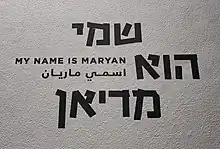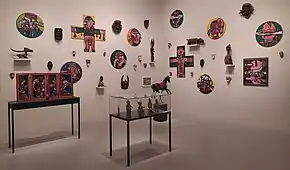Pinchas Burstein
Pinchas Burstein (1927–1977), later known as Maryan S. Maryan, was a Polish-born Jewish post-expressionist painter.
Maryan | |
|---|---|
 | |
| Born | Pinchas Burstein 1 January 1927 |
| Died | 15 June 1977 (aged 50) New York City, United States |
| Nationality | Polish, American |
| Known for | painting |
| Movement | post-expressionism |
Early life
My name is Maryan S. Maryan. I was born in Nowy Sącz 1.1.1927 … I was sent to summer camps with many other kids from all over Poland. It was close to my hometown. We used to say to each other: next year same place... the following year instead of summer colonies I found myself at Auschwitz.
Maryan[1]

Pinchas Burstein (Pinkas Bursztyn) was born in Nowy Sącz, Poland,[2] on January 1, 1927,[1] the second son of an Orthodox Jewish family.[3] His mother was Gitel Burstein;[4] his father, Avraham Schindel, was a baker.[5] Burstein was 12 when the Nazis invaded Poland in 1939.[2] He lived in the Rzeszów Ghetto in 1942–1943, in which period he was shot in the neck while delivering food to Jews in hiding.[3] In 1943[4] or 1944 he was sent to the Auschwitz concentration camp and worked in Gleiwitz.[1] Burstein was given the inmate number A17986.[1] On the night of his arrival[1] he was chosen as one of 22 Jews who were to be shot, but survived.[4] In 1945, when the Soviet army liberated prisoners of the Auschwitz death camp, Burstein was found "wounded among bodies in a lime pit", and had his leg amputated.[3][4][2] After the war, in 1946, he left Poland[1] and spent two years in Germany in camps for displaced persons.[3] Burstein was the only member of his family to survive the Holocaust.[3]
Israel and France
In 1947 Burstein moved to Palestine. In a later interview he said that he had been persuaded to move there while in a displaced persons camp, but once he arrived, found himself labeled "handicapped" and sent to a kibbutz that had "a residence for elderly and disabled immigrants".[4]
After I received the certificate, they left me alone on the platform. No one came to me. I found a pile of oranges and sat on it. I waited. Yes, I waited for someone to come and take me to the kibbutz, as that official had promised me. I waited for several hours and suddenly I was horrified. I began to see the truth. No one was waiting for me. This clerk, his name will be omitted, lied to me. They left me on the platform. After a while I realized that it was worse than a concentration camp, because I was not alone there, we went to die together, whereas on the platform at the port of Haifa I went to die alone.[4]
He left that kibbutz after five months, when he was admitted in the Bezalel Academy of Art and Design in Jerusalem.[4] He saw the Israeli War of Independence and creation of the state of Israel, and witnessed Battle for Jerusalem.[1] His first solo exhibition was at the YMCA in Jerusalem.[6] In 1950 Burstein arrived in Paris,[2] where he studied at the Ecole Nationale Superieure des Beaux-Arts for three years, including two in the lithography workshop.
In Paris Pinchas Burstein took a new name, Maryan Bergman,[3] "which he "borrowed" from his schoolmate in Bezalel, the painter Marian (Meir Marinel), who committed suicide a few years later."[4] There, he had works included in several major exhibitions and was commissioned to design a tapestry for the Monument to the Unknown Jewish Martyr in Paris, and was awarded the Prix des Critiques d’Art at the Paris Biennale. His first solo exhibition in the United States was held at the famed André Emmerich Gallery in 1960.[6]
USA
Most of the things written about me are empty of content. They also say that I am a bad person (this is also true). As for my paintings, I officially declare that I would call them true paintings.
Maryan[4]


Maryan moved to New York in 1962, after being denied French citizenship. Together with his wife, Annette, a Holocaust survivor he met in France,[4] he arrived in the USA aboard the SS Leonardo da Vinci.[1] In 1969 he received American citizenship and officially changed his name to Maryan S. Maryan.[2]
His best-known works, the movie Ecce Homo,[2] the painting After Goia,[3] and a series of paintings called Personnage, were done in New York.[6] The Personnage paintings were described by Grace Glueck as
brutal, exaggerated Piccasoid forms in which could be seen the influence also of Dubuffet and the CoBrA group of young European painters that included Karel Appel and Asger Jorn. They were mocking, clownish zombies with mask-like faces and lolling tongues, suggesting visual realizations of characters from Gunter Grass's Tin Drum. Later, they got wider and more gestural, with maybe a touch of de Kooning, winding up as slobbering, almost illegible bundles of mouths, flailing limbs, and flying organs.[6]
In 1971 Maryan had a mental breakdown, and temporarily lost his ability to speak.[2][1] To overcome this state, his psychiatrist told him to draw depictions of his life story. In a year he created a series of drawings, later titled Ecce homo, and completed 9 notebooks with 478 drawings, each 20x30 cm.[1][2] Daniel Kupermann examined these drawings as a psychoanalyst, and found them to be a "blend of infantile and monstrous, with their incontinent bodies and with the omnipresence of death in the form of grotesque terror-filled faces, seem to reveal an attempt to find a language in images that is able to transmit the experience of the obscene tragedy lived by the inmates of concentration camps".[2]
In 1975 Maryan and Kenny Schneider created a 90-minute film, also titled Ecce homo, in his hotel. Katarzyna Bojarska describes the film as
a series of staged recollections where photographic images and reproductions of Maryan’s paintings, drawings, and lithographs alternate with a disturbing performance. Maryan reenacts Holocaust memories with the use of numerous accessories such as an M16 gun, dummies of SS officers, a straitjacket, ropes, and paint. The film opens with the following sequences of images appearing one after another: the Virgin Mary, women in robes during a Ku-Klux-Klan ceremony, Maryan himself in a black dress resembling a cassock with his arms stretched wide (as if crucified), Yasser Arafat, the Pope on a stool, images of crucifixion, a black cloth with a white swastika on it, black crosses on the white robes of Ku-Klux-Klan members, the shooting of Maryan as a Nazi, black tape covers his eyes and mouth, then pictures of Pinochet, Napoleon, Maximilian Kolbe (with the camp number 214510672 on his chest), piles of corpses from the Mỹ Lai massacre, Christ in a crown of thorns covered in paint. Religious motifs, iconic images of historical events and people, press clips and holy images are all montaged in a sequence that stimulates imagination and affect, driving both to the very limits of alarm.[1]
Maryan lived in the Chelsea Hotel in New York.[6] He died of a heart attack in his hotel room in 1977,[3][6] and was buried in the Montparnasse cemetery in Paris.
References
- Bojarska, Katarzyna (2013). "Maryan, or the Life in Death". Widok. Teorie I Praktyki Kultury Wizualnej (4). doi:10.36854/widok/2013.4.1267. Retrieved 25 January 2023.
- Kupermann, Daniel (1 June 2022). "Social Trauma and Testimony: A Reading of Maryan S. Maryan's Notebooks Inspired by Sándor Ferenczi". The American Journal of Psychoanalysis. 82 (2): 268–280. doi:10.1057/s11231-022-09354-x. ISSN 1573-6741. PMID 35761031. S2CID 250090418.
- Artner, Alan G. "Misanthrope Exhibition Gives Full Vent To Maryan's Beastly Visions". chicagotribune.com. Archived from the original on 2016-03-04. Retrieved 25 January 2023.
- "A great artist of a cursed period: like his life, the works of Pinchas Burstein, Marian, merged tragedy and flamboyant life". israelhayom.co.il. Retrieved 25 January 2023.
- Glueck, Grace (15 February 1985). "ART: SURVEY OF PAINTINGS BY MARYAN AT 2 GALLERIES". The New York Times. Retrieved 25 January 2023.
- "Maryan - Artists - Venus Over Manhattan". www.venusovermanhattan.com. Retrieved 25 January 2023.
Further reading
- Bojarczuk, Krzysztof. POKÓJ MARYANA / MARYAN'S ROOM.
External links
- "My Name is Maryan" exhibition at Tel Aviv Museum of Art
- "My Name is Maryan" exhibition at The Museum of Contemporary Art, North Miami
- Recording the Survival, interview with "My Name is Maryan" exhibition curator
- Works at MoMA
- La ménagerie humaine (in French)